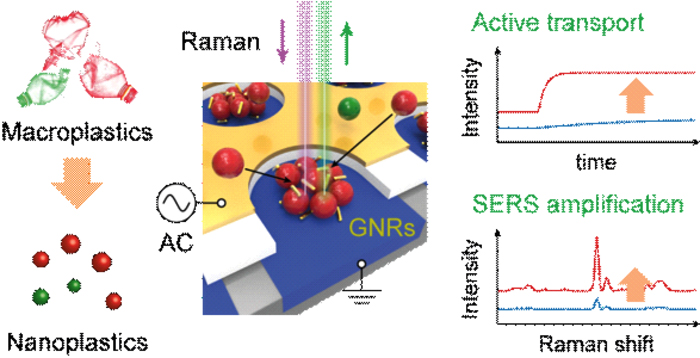Capturing nanoplastics in tap water with light

Raman-spectroscopy-based nanoplastic detection using the electric-optical tweezer and via surface-enhanced Raman scattering and the subsequent amplification of optical signals as well as the reduction of the accumulation time. Top right: Mimetic diagram of subsequent accumulation time reduction (blue: existing, red: current research) Bottom right: Mimetic diagram of subsequent amplification of optical signal accordingly (blue: existing, red: current research)
Credit: Korea Institute of Science and Technology
Electro-photonic tweezer captures and detects trace amount of nanoplastics through surface-enhanced Raman scattering, Application in safe water resource management technology.
Nanoplastics are plastics that have been discarded from our daily lives and that enter ecosystems in the size scale below 1 micro-metter after their physical and chemical disintegration. Recent research has shown that the concentration of microplastics in the major rivers in South Korea is the highest worldwide; it is not unusual to find news reports about the detection of microplastics in simple tea bags or drinking water and nanoplastic is the worse. The impact of micro/nanoplastics on human health and the environment in general is considered to be significant. However, the detection of nanoplastic is limited because their concentration is low and their size is extremely small. In addition, the detection process requires a few hours to days, and incurs significant costs during the pre-processing step of concentrating the plastic sample.
The research team of Dr. Yong-sang Ryu at the Brain Research Institute of the Korea Institute of Science and Technology (KIST) used an electro-photonic tweezer along with metal nanoparticles to concentrate ultrafine nanoplastics within a short period, and they reported the development of a real-time detection system using light.
The research team supplied electricity to a large-area vertically-aligned metals sandwiched by nanofilm insulator. They conducted Raman spectroscopy, which analyzes the energy difference between the incident and scattered light according to the frequency of the molecule. By combination of two technique: electrical nanoparticle capture together with real-time Raman spectroscoy, the research team achive in-situ the detection of a 30-nm 10 μg L-1 polystyrene particle with the help of gold nanoplarticles via Surface-enhanced Raman spectroscopy.
Moreover, the research team easily separated the particle from the sample through the dielectrophoresis phenomenon. Thus, the entire process including the collection, separation, and analysis for nanoplastics analysis, , which previously required at least one day, was drastically reduced to several seconds by employing an original technology that separates and detects plastics using one platform.
Researchers Euitae Jeong and Dr. Eui-Sang Yu (common lead author) at KIST, who performed this research, reported that “the findings of this research are meaningful in that ultrahigh-sensitivity detection of microplastics in real-time has become possible, and the proposed approach can be extended to the measurement of the microplastic concentration in various water resources and applied as a water resource securement technology.“
KIST was established in 1966 as the first government-funded research institute in Korea. KIST now strives to solve national and social challenges and secure growth engines through leading and innovative research. For more information, please visit KIST’s website at https://eng.kist.re.kr/
This research was carried out as a major project of KIST with the support of the Ministry of Science and ICT (Minister Jongho Lee); the results have been reported as a cover paper in the latest international journal 「ACS Nano」 (IF: 18.027).
Journal: ACS Nano
DOI: 10.1021/acsnano.2c07933
Article Title: Real-time Underwater Nanoplastic Detection Beyond Diffusion Limit and Low Raman Scattering Cross-section via Electro-photonic Tweezers
Article Publication Date: 27-Dec-2022
All latest news from the category: Ecology, The Environment and Conservation
This complex theme deals primarily with interactions between organisms and the environmental factors that impact them, but to a greater extent between individual inanimate environmental factors.
innovations-report offers informative reports and articles on topics such as climate protection, landscape conservation, ecological systems, wildlife and nature parks and ecosystem efficiency and balance.
Newest articles

Trotting robots reveal emergence of animal gait transitions
A four-legged robot trained with machine learning by EPFL researchers has learned to avoid falls by spontaneously switching between walking, trotting, and pronking – a milestone for roboticists as well…

Innovation promises to prevent power pole-top fires
Engineers in Australia have found a new way to make power-pole insulators resistant to fire and electrical sparking, promising to prevent dangerous pole-top fires and reduce blackouts. Pole-top fires pose…

Possible alternative to antibiotics produced by bacteria
Antibacterial substance from staphylococci discovered with new mechanism of action against natural competitors. Many bacteria produce substances to gain an advantage over competitors in their highly competitive natural environment. Researchers…





















